Published November 20, 2013 at 1:16 p.m.
Forget for a second about the graphic sex scenes and the attendant controversies. I was struck by something different in this Palme d’Or winner from cowriter-director Abdellatif Kechiche — namely, how much its protagonist (Adèle Exarchopoulos) loves to eat. The film features so many scenes of the young woman wolfing down her favorite spaghetti Bolognese that viewers may leave with a craving for the dish.
Those scenes, of course, form a relatively small portion of this three-hour movie that chronicles the “life of Adèle” (the film’s original French title) from the lycée to young adulthood. Based on a graphic novel by Julie Maroh, Blue Is the Warmest Color tells a fairly standard coming-of-age story in which girl meets boy, girl gets bored with boy’s intellectual limitations, girl meets girl (Léa Seydoux), things get intense, and then things get complicated. Besides eating and the aforementioned sex, it features plenty of scenes in which the heroine discusses literature and art, teaches kids to spell, messes with her hair, smokes, sleeps, pouts and stares.
But I noticed the eating because it’s indicative of the stubborn focus on pleasures — sensuous, sensual and intellectual — that makes Blue Is the Warmest Color so much more powerful than just another European slice-of-life drama. The movie gave me a sneaking sense that, for all the flesh, blood and guts on our screens, few American movies make it look fun just to inhabit a human body.
Sure, Hollywood flicks often appeal to audience hedonism, but rarely do they show their characters wallowing in sensory gratification. If our stars binged on spaghetti on screen, they might lose their perfect waistlines. They’d certainly lose their aura of coolness and control.
It’s not just noteworthy that Kechiche shows his leading lady losing control — repeatedly, joyfully and sadly and in many other ways — but how he shows it. The camera sticks so close to Adèle — and later to her lover, the older art student Emma — that we see every tear smudge and pockmark. One long, key scene plays out entirely in close-ups before Kechiche finally grants us an establishing shot of the locale.
Vérité-style “intimacy” is common in indie dramas these days. But Kechiche commits so fully to the method that the movie may induce a kind of hypnosis in some viewers. (Others may feel claustrophobic.) It’s difficult to describe Exarchopoulos’ and Seydoux’s performances because it’s so easy to forget they’re even acting.
Some have suggested that watching Blue is like being Adèle, but it’s really more like being obsessed with her. The film calls to mind a common theme of French literature: Love can turn an ordinary person into an object of endless fascination, and art can convey that fascination to others.
That process always entails a certain voyeurism, as we’re reminded when Emma displays her nude paintings of Adèle to her sophisticated friends. (Adèle’s choice not to create art herself is a bone of contention between them.) If anything, Kechiche’s intrusive, lingering camera is even more questionable in its intent, making each love scene into something of a threesome.
So is the movie exploitive, as some have charged? Yes — but so are Schiele and Renoir. At a time when big-screen portrayals of young women — and, perhaps, of people generally — tend to take stylized, focus-group-approved forms, Blue uses consummate art to celebrate the messiness of being Adèle. Far from being a lesbian “heroine” or any kind of archetype, she’s just another young person muddling through life and love, reading voraciously, figuring things out and slurping up spaghetti on her way. Somehow the film turns her loose-ends life into an indelible portrait.
More By This Author
Speaking of Movies, movie Review
-

Next Month Brings the Final Curtain for Palace 9 Cinemas
Oct 27, 2023 -

Book Review: 'Save Me a Seat! A Life With Movies,' Rick Winston
Aug 30, 2023 -

Steve MacQueen Named Executive Director of Vermont International Film Festival
May 22, 2023 -

Vermonters Are Going Back to the Movies — Under the Stars
Aug 26, 2020 -

Where to Catch a Movie Near Burlington
Sep 11, 2018 - More »
Comments
Comments are closed.
From 2014-2020, Seven Days allowed readers to comment on all stories posted on our website. While we've appreciated the suggestions and insights, right now Seven Days is prioritizing our core mission — producing high-quality, responsible local journalism — over moderating online debates between readers.
To criticize, correct or praise our reporting, please send us a letter to the editor or send us a tip. We’ll check it out and report the results.
Online comments may return when we have better tech tools for managing them. Thanks for reading.












































